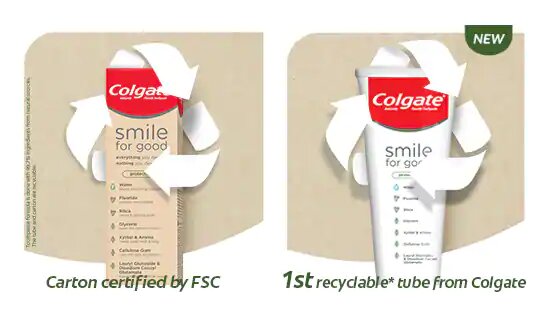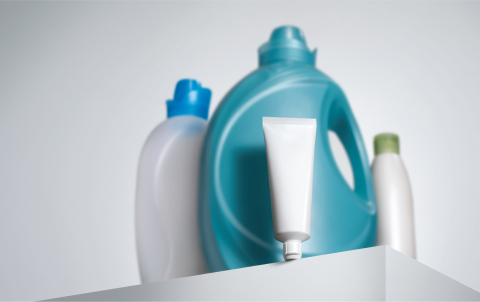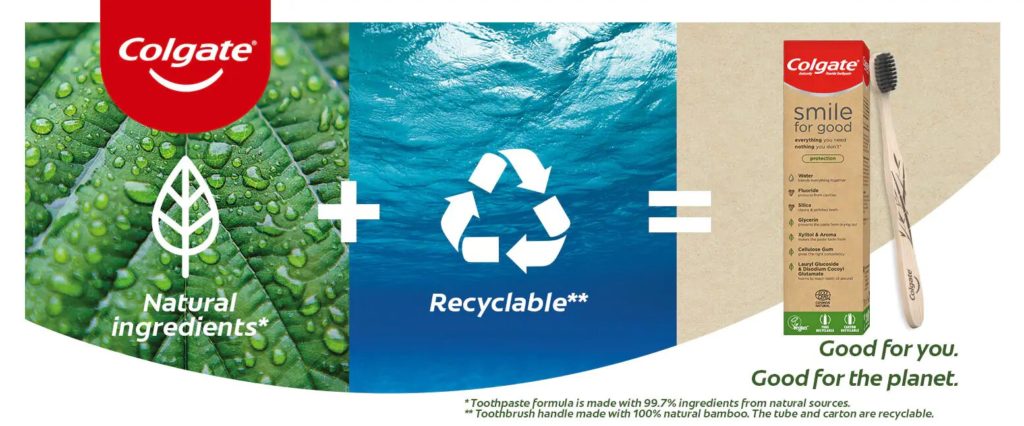In 2014, Colgate issued its first formal packaging sustainability goals, which included a commitment for all packaging to be recyclable by 2020 for three categories: Pet Nutrition, Home Care, and Personal Care. Conspicuous for its absence was our big Oral Care business. There, against the daunting challenge of making toothpaste tubes recyclable, our 2020 commitment was to formulate “breakthrough innovation.” The goal, successfully achieved, was to kick-start the scientific work that led to a first-of-its-kind recyclable toothpaste tube release in 2019.
What Does Recyclable Mean?
Along with over 450 organizations, including The Consumer Goods Forum (CGF), we’ve adopted the definition of recyclability that underpins the Ellen MacArthur Foundation’s (EMF) Global Commitment: a package or packaging component is recyclable if its successful post-consumer collection, sorting, and recycling is proven to work in practice and at scale. While we are aligned on this approach, it is not always clear what our design target should be — testing protocols are not aligned globally, some organizations choose a stricter definition than others, and there is a wide range of collection infrastructures. It’s still important to educate our stakeholders, to include our extremely important internal staff, on this definition and the important need to ensure both recyclability and recycling in practice and at scale, and to base the packaging design efforts towards materials that have the best chance of meeting that goal.
For our recyclable tube, we wanted to “begin with the end in mind” and ensure actual compatibility with an existing recycling stream, and for this important aspect we turned to the Association of Plastics Recyclers (APR) for design guidance, testing protocols, and general support of APR’s amazing network. Most of today’s toothpaste tubes are made from sheets of plastic laminate – usually a combination of different plastics – often sandwiched around a thin layer of aluminum. The mix of materials makes it impossible to recycle through conventional methods, even with a significant portion of polyethylene (PE).
HDPE had been thought to be too rigid to make a squeezable tube; however, we chose this stream because it is already widely recycled. Colgate engineers figured out how to combine different grades and thicknesses of HDPE laminate into a tube that meets bottle recycling standards, protects the product, and holds up to the demands of high-speed production, all while remaining comfortably squeezable.
We’ve been able to engage with Plastics Recyclers Europe as well, and as with APR, our breakthrough recyclable tube design was the first to be considered and recognized as technically recyclable, a critical first step towards integration of the tube into an existing, successfully collected stream. We decided to maintain Colgate’s TerraCycle Oral Care Waste collection program to provide for an alternative collection option during the transition.
Explaining why tubes designed for recyclability should be accepted in the existing HDPE stream continues to be a challenge, partly because HDPE is dominated by bottles, and also because most tubes are not thought to be recyclable. Many people assume that to recycle tubes, we need to create a new stream and collection system, and that such a new stream would be used for certain niche products. This approach would actually be counter-productive to widespread acceptance and collection of tubes, and our goal remains laser-focused on making tubes a key part of the circular economy rather than “downcycling” the valuable HDPE material. Additionally, while PP caps on HDPE packages are an industry norm, we recognize that they can be a contaminant in the HDPE stream and that is also a focus area.
A Unique Approach, and Collaboration is Key
From the beginning of our tube innovation journey, we knew that it would be important to help drive our entire industry towards change. Since our 2014 commitment and 2020 goals, we’ve updated and expanded to include recyclability for all packaging to include toothpaste tubes by 2025. This means that Colgate has started to extensively transform its own manufacturing base, as well as highlighting to other companies the question of tube recyclability. To a marketer or sales professional, it’s challenging to embrace the concept of sharing a hard-won victory. But we know that having only one or even several brands on the market in a recyclable format will be confusing to people, and the last thing recycling systems need is more confusion! With system transformation in mind, we’ve shared information about available technologies, including our own, with over 15 companies so far.
We’ve also engaged quite extensively with key players involved with recycling, and it’s sometimes helpful to realize that it’s not easy to be first — not all are supportive or understand the significant challenges brands and manufacturers face. We’ve heard our fair share of push-back: “We aren’t going to be able to sort tubes by brand. We don’t accept this Technology Approval in this Country. If you label this tube as recyclable, everyone will think all tubes are recyclable and you’ll increase contamination.” And my personal favorite, “Have you talked to every MRF to ensure they’ll accept this tube?” While not a practical suggestion given there are thousands of MRFs worldwide, indeed these are important stakeholder perspectives that highlight the need for brands and the tube manufacturers to quickly transform, and our view is the old adage, “you have to start somewhere.”
We are confident that by choosing the HDPE bottle stream as the target for tube circularity, and by partnering with both globally-focused and regionally-relevant organizations, including the Ellen MacArthur Foundation and The Recycling Partnership in the U.S., we can make our vision into a reality. We also have to think about tubes as a category: the world of tubes extends well beyond toothpaste, most notably in personal care. The U.S.-based consultancy More Recycling has been working for several years to understand how tubes can best fit into the recycling system, and Colgate is excited to have joined the effort. With additional E.U.-based experts, More Recycling now manages “Tube Working Groups” in the U.S. and Europe, that include relevant brands and suppliers working towards the same goal.
Our sustainability journey will continue, and our 2019 Sustainability Report was just released tracking our progress. We look forward to continuing to lead the way for tube circularity as the world continues to reshape the way we do business. We are excited for the CGF Plastics Waste Coalition of Action group, which also endorses the Ellen MacArthur Foundation’s vision of a New Plastics Economy, to bring focus and resources to the challenges we all face beyond tubes, and to rebuild a better economy where waste is designed out of the system.
This post was written and contributed by:
Anne Bedarf
Global Packaging Sustainability Manager
Colgate-Palmolive



